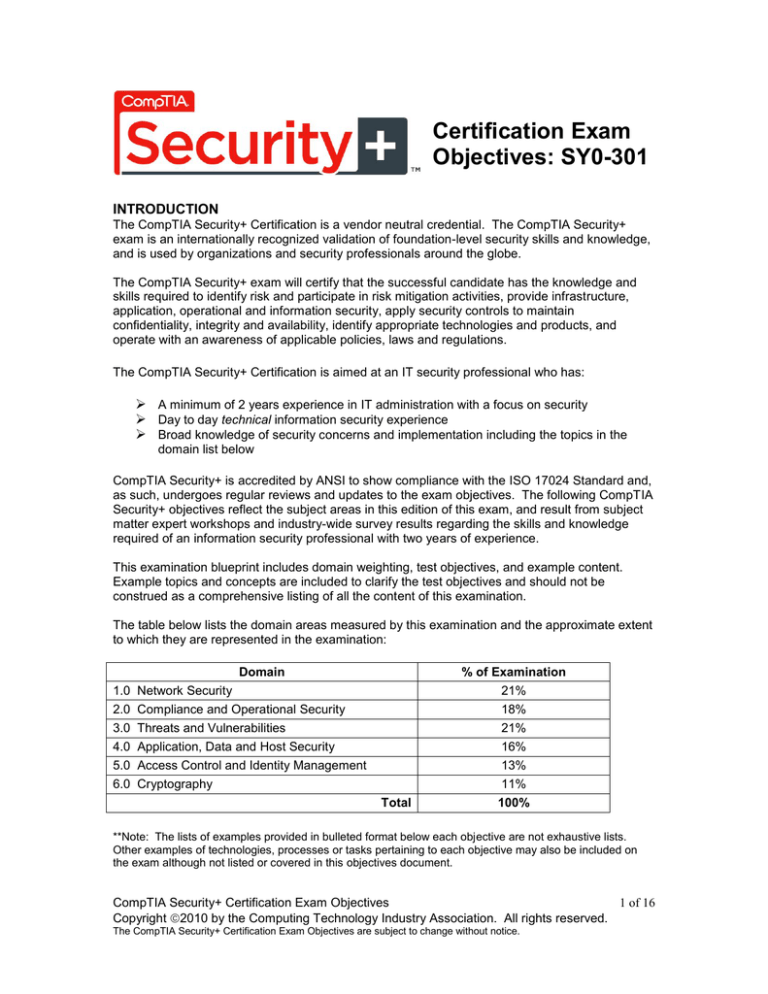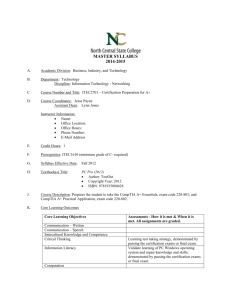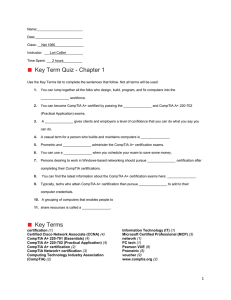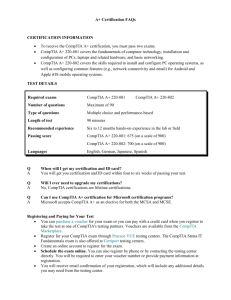Certification Exam Objectives: SY0-301 INTRODUCTION
advertisement

Certification Exam Objectives: SY0-301 INTRODUCTION The CompTIA Security+ Certification is a vendor neutral credential. The CompTIA Security+ exam is an internationally recognized validation of foundation-level security skills and knowledge, and is used by organizations and security professionals around the globe. The CompTIA Security+ exam will certify that the successful candidate has the knowledge and skills required to identify risk and participate in risk mitigation activities, provide infrastructure, application, operational and information security, apply security controls to maintain confidentiality, integrity and availability, identify appropriate technologies and products, and operate with an awareness of applicable policies, laws and regulations. The CompTIA Security+ Certification is aimed at an IT security professional who has: A minimum of 2 years experience in IT administration with a focus on security Day to day technical information security experience Broad knowledge of security concerns and implementation including the topics in the domain list below CompTIA Security+ is accredited by ANSI to show compliance with the ISO 17024 Standard and, as such, undergoes regular reviews and updates to the exam objectives. The following CompTIA Security+ objectives reflect the subject areas in this edition of this exam, and result from subject matter expert workshops and industry-wide survey results regarding the skills and knowledge required of an information security professional with two years of experience. This examination blueprint includes domain weighting, test objectives, and example content. Example topics and concepts are included to clarify the test objectives and should not be construed as a comprehensive listing of all the content of this examination. The table below lists the domain areas measured by this examination and the approximate extent to which they are represented in the examination: Domain 1.0 2.0 3.0 4.0 5.0 6.0 % of Examination Network Security Compliance and Operational Security Threats and Vulnerabilities Application, Data and Host Security Access Control and Identity Management Cryptography Total 21% 18% 21% 16% 13% 11% 100% **Note: The lists of examples provided in bulleted format below each objective are not exhaustive lists. Other examples of technologies, processes or tasks pertaining to each objective may also be included on the exam although not listed or covered in this objectives document. CompTIA Security+ Certification Exam Objectives 1 of 16 Copyright 2010 by the Computing Technology Industry Association. All rights reserved. The CompTIA Security+ Certification Exam Objectives are subject to change without notice. 1.0 Network Security 1.1 Explain the security function and purpose of network devices and technologies Firewalls Routers Switches Load Balancers Proxies Web security gateways VPN concentrators NIDS and NIPS (Behavior based, signature based, anomaly based, heuristic) Protocol analyzers Sniffers Spam filter, all-in-one security appliances Web application firewall vs. network firewall URL filtering, content inspection, malware inspection 1.2 Apply and implement secure network administration principles Rule-based management Firewall rules VLAN management Secure router configuration Access control lists Port Security 802.1x Flood guards Loop protection Implicit deny Prevent network bridging by network separation Log analysis 1.3 Distinguish and differentiate network design elements and components DMZ Subnetting VLAN NAT Remote Access Telephony NAC Virtualization Cloud Computing o Platform as a Service o Software as a Service o Infrastructure as a Service 1.4 Implement and use common protocols IPSec SNMP CompTIA Security+ Certification Exam Objectives 2 of 16 Copyright 2010 by the Computing Technology Industry Association. All rights reserved. The CompTIA Security+ Certification Exam Objectives are subject to change without notice. SSH DNS TLS SSL TCP/IP FTPS HTTPS SFTP SCP ICMP IPv4 vs. IPv6 1.5 Identify commonly used default network ports FTP SFTP FTPS TFTP TELNET HTTP HTTPS SCP SSH NetBIOS 1.6 Implement wireless network in a secure manner WPA WPA2 WEP EAP PEAP LEAP MAC filter Disable SSID broadcast TKIP CCMP Antenna Placement Power level controls 2.0 Compliance and Operational Security 2.1 Explain risk related concepts Control types o Technical o Management o Operational False positives Importance of policies in reducing risk o Privacy policy o Acceptable use o Security policy o Mandatory vacations CompTIA Security+ Certification Exam Objectives 3 of 16 Copyright 2010 by the Computing Technology Industry Association. All rights reserved. The CompTIA Security+ Certification Exam Objectives are subject to change without notice. o Job rotation o Separation of duties o Least privilege Risk calculation o Likelihood o ALE o Impact Quantitative vs. qualitative Risk-avoidance, transference, acceptance, mitigation, deterrence Risks associated to Cloud Computing and Virtualization 2.2 Carry out appropriate risk mitigation strategies Implement security controls based on risk Change management Incident management User rights and permissions reviews Perform routine audits Implement policies and procedures to prevent data loss or theft 2.3 Execute appropriate incident response procedures Basic forensic procedures o Order of volatility o Capture system image o Network traffic and logs o Capture video o Record time offset o Take hashes o Screenshots o Witnesses o Track man hours and expense Damage and loss control Chain of custody Incident response: first responder 2.4 Explain the importance of security related awareness and training Security policy training and procedures Personally identifiable information Information classification: Sensitivity of data (hard or soft) Data labeling, handling and disposal Compliance with laws, best practices and standards User habits o Password behaviors o Data handling o Clean desk policies o Prevent tailgating o Personally owned devices Threat awareness o New viruses o Phishing attacks o Zero days exploits Use of social networking and P2P 2.5 Compare and contrast aspects of business continuity Business impact analysis CompTIA Security+ Certification Exam Objectives 4 of 16 Copyright 2010 by the Computing Technology Industry Association. All rights reserved. The CompTIA Security+ Certification Exam Objectives are subject to change without notice. Removing single points of failure Business continuity planning and testing Continuity of operations Disaster recovery IT contingency planning Succession planning 2.6 Explain the impact and proper use of environmental controls HVAC Fire suppression EMI shielding Hot and cold aisles Environmental monitoring Temperature and humidity controls Video monitoring 2.7 Execute disaster recovery plans and procedures Backup / backout contingency plans or policies Backups, execution and frequency Redundancy and fault tolerance o Hardware o RAID o Clustering o Load balancing o Servers High availability Cold site, hot site, warm site Mean time to restore, mean time between failures, recovery time objectives and recovery point objectives 2.8 Exemplify the concepts of confidentiality, integrity and availability (CIA) 3.0 Threats and Vulnerabilities 3.1 Analyze and differentiate among types of malware Adware Virus Worms Spyware Trojan Rootkits Backdoors Logic bomb Botnets 3.2 Analyze and differentiate among types of attacks Man-in-the-middle DDoS DoS Replay Smurf attack CompTIA Security+ Certification Exam Objectives 5 of 16 Copyright 2010 by the Computing Technology Industry Association. All rights reserved. The CompTIA Security+ Certification Exam Objectives are subject to change without notice. Spoofing Spam Phishing Spim Vishing Spear phishing Xmas attack Pharming Privilege escalation Malicious insider threat DNS poisoning and ARP poisoning Transitive access Client-side attacks 3.3 Analyze and differentiate among types of social engineering attacks Shoulder surfing Dumpster diving Tailgating Impersonation Hoaxes Whaling Vishing 3.4 Analyze and differentiate among types of wireless attacks Rogue access points Interference Evil twin War driving Bluejacking Bluesnarfing War chalking IV attack Packet sniffing 3.5 Analyze and differentiate among types of application attacks Cross-site scripting SQL injection LDAP injection XML injection Directory traversal/command injection Buffer overflow Zero-day Cookies and attachments Malicious add-ons Session hijacking Header manipulation 3.6 Analyze and differentiate among types of mitigation and deterrent techniques Manual bypassing of electronic controls o Failsafe/secure vs. failopen Monitoring system logs o Event logs o Audit logs CompTIA Security+ Certification Exam Objectives 6 of 16 Copyright 2010 by the Computing Technology Industry Association. All rights reserved. The CompTIA Security+ Certification Exam Objectives are subject to change without notice. o Security logs o Access logs Physical security o Hardware locks o Mantraps o Video surveillance o Fencing o Proximity readers o Access list Hardening o Disabling unnecessary services o Protecting management interfaces and applications o Password protection o Disabling unnecessary accounts Port security o MAC limiting and filtering o 802.1x o Disabling unused ports Security posture o Initial baseline configuration o Continuous security monitoring o remediation Reporting o Alarms o Alerts o Trends Detection controls vs. prevention controls o IDS vs. IPS o Camera vs. guard 3.7 Implement assessment tools and techniques to discover security threats and vulnerabilities Vulnerability scanning and interpret results Tools o Protocol analyzer o Sniffer o Vulnerability scanner o Honeypots o Honeynets o Port scanner Risk calculations o Threat vs. likelihood Assessment types o Risk o Threat o Vulnerability Assessment technique o Baseline reporting o Code review o Determine attack surface o Architecture o Design reviews 3.8 Within the realm of vulnerability assessments, explain the proper use of penetration testing versus vulnerability scanning CompTIA Security+ Certification Exam Objectives 7 of 16 Copyright 2010 by the Computing Technology Industry Association. All rights reserved. The CompTIA Security+ Certification Exam Objectives are subject to change without notice. Penetration testing o Verify a threat exists o Bypass security controls o Actively test security controls o Exploiting vulnerabilities Vulnerability scanning o Passively testing security controls o Identify vulnerability o Identify lack of security controls o Identify common misconfiguration Black box White box Gray box 4.0 Application, Data and Host Security 4.1 Explain the importance of application security Fuzzing Secure coding concepts o Error and exception handling o Input validation Cross-site scripting prevention Cross-site Request Forgery (XSRF) prevention Application configuration baseline (proper settings) Application hardening Application patch management 4.2 Carry out appropriate procedures to establish host security Operating system security and settings Anti-malware o Anti-virus o Anti-spam o Anti-spyware o Pop-up blockers o Host-based firewalls Patch management Hardware security o Cable locks o Safe o Locking cabinets Host software baselining Mobile devices o Screen lock o Strong password o Device encryption o Remote wipe/sanitization o Voice encryption o GPS tracking Virtualization 4.3 Explain the importance of data security CompTIA Security+ Certification Exam Objectives 8 of 16 Copyright 2010 by the Computing Technology Industry Association. All rights reserved. The CompTIA Security+ Certification Exam Objectives are subject to change without notice. Data Loss Prevention (DLP) Data encryption o Full disk o Database o Individual files o Removable media o Mobile devices Hardware based encryption devices o TPM o HSM o USB encryption o Hard drive Cloud computing 5.0 Access Control and Identity Management 5.1 Explain the function and purpose of authentication services RADIUS TACACS TACACS+ Kerberos LDAP XTACACS 5.2 Explain the fundamental concepts and best practices related to authentication, authorization and access control Identification vs. authentication Authentication (single factor) and authorization Multifactor authentication Biometrics Tokens Common access card Personal identification verification card Smart card Least privilege Separation of duties Single sign on ACLs Access control Mandatory access control Discretionary access control Role/rule-based access control Implicit deny Time of day restrictions Trusted OS Mandatory vacations Job rotation 5.3 Implement appropriate security controls when performing account management Mitigates issues associated with users with multiple account/roles Account policy enforcement CompTIA Security+ Certification Exam Objectives 9 of 16 Copyright 2010 by the Computing Technology Industry Association. All rights reserved. The CompTIA Security+ Certification Exam Objectives are subject to change without notice. o Password complexity o Expiration o Recovery o Length o Disablement o Lockout Group based privileges User assigned privileges 6.0 Cryptography 6.1 Summarize general cryptography concepts Symmetric vs. asymmetric Fundamental differences and encryption methods o Block vs. stream Transport encryption Non-repudiation Hashing Key escrow Steganography Digital signatures Use of proven technologies Elliptic curve and quantum cryptography 6.2 Use and apply appropriate cryptographic tools and products WEP vs. WPA/WPA2 and preshared key MD5 SHA RIPEMD AES DES 3DES HMAC RSA RC4 One-time-pads CHAP PAP NTLM NTLMv2 Blowfish PGP/GPG Whole disk encryption TwoFish Comparative strengths of algorithms Use of algorithms with transport encryption o SSL o TLS o IPSec o SSH o HTTPS CompTIA Security+ Certification Exam Objectives 10 of 16 Copyright 2010 by the Computing Technology Industry Association. All rights reserved. The CompTIA Security+ Certification Exam Objectives are subject to change without notice. 6.3 Explain the core concepts of public key infrastructure Certificate authorities and digital certificates o CA o CRLs PKI Recovery agent Public key Private key Registration Key escrow Trust models 6.4 Implement PKI, certificate management and associated components Certificate authorities and digital certificates o CA o CRLs PKI Recovery agent Public key Private keys Registration Key escrow Trust models CompTIA Security+ Certification Exam Objectives 11 of 16 Copyright 2010 by the Computing Technology Industry Association. All rights reserved. The CompTIA Security+ Certification Exam Objectives are subject to change without notice. SECURITY+ ACRONYMS 3DES – Triple Digital Encryption Standard AAA – Authentication, Authorization, and Accounting ACL – Access Control List AES - Advanced Encryption Standard AES256 – Advanced Encryption Standards 256bit AH - Authentication Header ALE - Annualized Loss Expectancy AP - Access Point API - Application Programming Interface ASP - Application Service Provider ARO - Annualized Rate of Occurrence ARP - Address Resolution Protocol AUP - Acceptable Use Policy BCP – Business Continuity Planning BIOS – Basic Input / Output System BOTS – Network Robots CA – Certificate Authority CAC - Common Access Card CAN - Controller Area Network CCMP – Counter-Mode/CBC-Mac Protocol CCTV - Closed-circuit television CERT – Computer Emergency Response Team CHAP – Challenge Handshake Authentication Protocol CIRT – Computer Incident Response Team CMM – Capability Maturity Model COOP – Continuity of Operation Planning CP – Contingency Planning CRC – Cyclical Redundancy Check CRL – Certification Revocation List CSU – Channel Service Unit DAC – Discretionary Access Control DDOS – Distributed Denial of Service DEP – Data Execution Prevention DES – Digital Encryption Standard DHCP – Dynamic Host Configuration Protocol DLL - Dynamic Link Library DLP - Data Loss Prevention DMZ – Demilitarized Zone DNS – Domain Name Service (Server) DOS – Denial of Service CompTIA Security+ Certification Exam Objectives 12 of 16 Copyright 2010 by the Computing Technology Industry Association. All rights reserved. The CompTIA Security+ Certification Exam Objectives are subject to change without notice. DRP – Disaster Recovery Plan DSA – Digital Signature Algorithm DSL - Digital Subscriber line DSU – Data Service Unit EAP - Extensible Authentication Protocol ECC - Elliptic Curve Cryptography EFS – Encrypted File System EMI – Electromagnetic Interference ESP – Encapsulated Security Payload FTP – File Transfer Protocol GPO – Group Policy Object GPU - Graphic Processing Unit GRE - Generic Routing Encapsulation HDD – Hard Disk Drive HIDS – Host Based Intrusion Detection System HIPS – Host Based Intrusion Prevention System HMAC – Hashed Message Authentication Code HSM – Hardware Security Module HTML – HyperText Markup Language HTTP – Hypertext Transfer Protocol HTTPS – Hypertext Transfer Protocol over SSL HVAC – Heating, Ventilation Air Conditioning IaaS - Infrastructure as a Service ICMP - Internet Control Message Protocol ID – Identification IKE – Internet Key Exchange IM - Instant messaging IMAP4 - Internet Message Access Protocol v4 IP - Internet Protocol IPSEC – Internet Protocol Security IRC - Internet Relay Chat ISP – Internet Service Provider ITCP – IT Contingency Plan IV - Initialization Vector KDC - Key Distribution Center L2TP – Layer 2 Tunneling Protocol LAN – Local Area Network LANMAN – Local Area Network Manager LDAP – Lightweight Directory Access Protocol LEAP – Lightweight Extensible Authentication Protocol MAC – Mandatory Access Control / Media Access Control MAC - Message Authentication Code CompTIA Security+ Certification Exam Objectives 13 of 16 Copyright 2010 by the Computing Technology Industry Association. All rights reserved. The CompTIA Security+ Certification Exam Objectives are subject to change without notice. MAN - Metropolitan Area Network MBR – Master Boot Record MD5 – Message Digest 5 MPLS – Multi-Protocol Layer Switch MSCHAP – Microsoft Challenge Handshake Authentication Protocol MTBF – Mean Time Between Failures MTTR – Mean Time to Recover MTU - Maximum Transmission Unit NAC – Network Access Control NAT – Network Address Translation NDA – Non-Disclosure Agreement NIDS – Network Based Intrusion Detection System NIPS – Network Based Intrusion Prevention System NIST – National Institute of Standards & Technology NOS – Network Operating System NTFS - New Technology File System NTLM – New Technology LANMAN NTP - Network Time Protocol OCSP – Online Certification Security Protocol OLA – Open License Agreement OS – Operating System OVAL – Open Vulnerability Assessment Language PAM – Pluggable Authentication Modules PAP – Password Authentication Protocol PAT - Port Address Translation PBX – Private Branch Exchange PCAP – Packet Capture PEAP – Protected Extensible Authentication Protocol PED - Personal Electronic Device PGP – Pretty Good Privacy PII – Personally Identifiable Information PIV – Personal Identity Verification PKI – Public Key Infrastructure POTS – Plain Old Telephone Service PPP - Point-to-point Protocol PPTP – Point to Point Tunneling Protocol PSK – Pre-Shared Key PTZ – Pan-Tilt-Zoom RA – Recovery Agent RAD - Rapid application development RADIUS – Remote Authentication Dial-in User Server RAID – Redundant Array of Inexpensive Disks CompTIA Security+ Certification Exam Objectives 14 of 16 Copyright 2010 by the Computing Technology Industry Association. All rights reserved. The CompTIA Security+ Certification Exam Objectives are subject to change without notice. RAS – Remote Access Server RBAC – Role Based Access Control RBAC – Rule Based Access Control RIPEMD – RACE Integrity Primitives Evaluation Message Digest ROI – Return of Investment RPO – Recovery Point Objective RSA – Rivest, Shamir, & Adleman RTO – Recovery Time Objective RTP – Real-Time Transport Protocol S/MIME – Secure / Multipurpose internet Mail Extensions SAML – Security Assertions Markup Language SaaS - Software as a Service SCAP - Security Content Automation Protocol SCSI - Small Computer System Interface SDLC - Software Development Life Cycle SDLM - Software Development Life Cycle Methodology SEH – Structured Exception Handler SHA – Secure Hashing Algorithm SHTTP – Secure Hypertext Transfer Protocol SIM – Subscriber Identity Module SLA – Service Level Agreement SLE - Single Loss Expectancy SMS - Short Message Service SMTP – Simple Mail Transfer Protocol SNMP - Simple Network Management Protocol SOAP – Simple Object Access Point SONET – Synchronous Optical Network Technologies SPIM - Spam over Internet Messaging SSD – Solid State Drive SSH – Secure Shell SSL – Secure Sockets Layer SSO – Single Sign On STP – Shielded Twisted Pair TACACS – Terminal Access Controller Access Control System TCP/IP – Transmission Control Protocol / Internet Protocol TKIP - Temporal Key Integrity Protocol TLS – Transport Layer Security TPM – Trusted Platform Module TSIG – Transaction Signature UAT - User Acceptance Testing UEFI – Unified Extensible Firmware Interface UPS - Uninterruptable Power Supply CompTIA Security+ Certification Exam Objectives 15 of 16 Copyright 2010 by the Computing Technology Industry Association. All rights reserved. The CompTIA Security+ Certification Exam Objectives are subject to change without notice. URL - Universal Resource Locator USB – Universal Serial Bus UTP – Unshielded Twisted Pair VDI – Virtualization Desktop Infrastructure VLAN – Virtual Local Area Network VoIP - Voice over IP VPN – Virtual Private Network VTC – Video Teleconferencing WAF- Web-Application Firewall WAP – Wireless Access Point WEP – Wired Equivalent Privacy WIDS – Wireless Intrusion Detection System WIPS – Wireless Intrusion Prevention System WPA – Wireless Protected Access WTLS – Wireless TLS XML – Extensible Markup Language XSRF - Cross-Site Request Forgery XSRF- Cross-Site Request Forgery XSS - Cross-Site Scripting Version 2.0 CompTIA Security+ Certification Exam Objectives 16 of 16 Copyright 2010 by the Computing Technology Industry Association. All rights reserved. The CompTIA Security+ Certification Exam Objectives are subject to change without notice.




